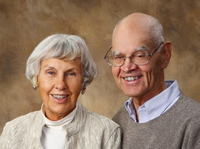Peter and Sandra Beak moved to Urbana in 1961 when Peter was appointed as an instructor in the chemistry department. 
Sandra (BS Miami (Ohio), MEd Illinois) joined the Urbana school system in 1969 and taught at Leal and King Schools for 25 years. She participated with Illinois and Eastern Illinois in supervising student teachers and collaborated with Illinois in programs which developed language acquisition by foreign students and provided multicultural education for all students.
Peter (BA Harvard, PhD Iowa State) worked with students in organic chemistry. His group carried out physical organic studies of structure, equilibria and reaction mechanisms. They discovered novel reaction pathways and developed new synthetic methods.
In early gas phase and solution studies he established that the stabilities of protomeric isomers are highly dependent on the molecular environment, provided a phenomenological theory to rationalize these effects, and developed a method for the equilibration of the corresponding alkyltropic isomers. Investigations of thiophillic additions to thiocarbonyl groups, of reactions involving carboxylium ions, of novel photochemical rearrangements, and of a model for the reaction of orotidine-5’-phosphate decarboxylase were carried out in his group.
The use of intra/intermolecular hydrogen/deuterium isotope effects was developed as a method to provide information about proton transfers which may occur after the transition state of a reaction. Beak developed the endocyclic restriction test to solve long-standing questions about the trajectories of reactions at non-stereogenic heteroatoms. This work established that first row atoms can be displaced by trigonal bipyramidal transition states and second and third row atoms can react either by that pathway or by an addition elimination process.
Beak’s work developed methods and concepts in organolithium carbanion chemistry. Directed lithiations, the intermediacy of dipole stabilized carbanions, and the operation of the complex induced proximity effect provided a number of useful carbanionic intermediates for investigation and application. His discovery and development of dynamic thermodynamic resolution provided a new strategy for identifying and improving enantioselective syntheses.
He was once asked what area of his research was most satisfying, and he replied, “Clearly it was working with my students. The opportunity to work and learn with them and be part of their development has been a privilege.”
Beak received awards and recognition for his teaching, service, and research including election to the Center for Advanced Study, the American Academy of Arts and Sciences, and the National Academy of Sciences.
Peter Beak passed away on February 21, 2021.
Remembering Peter Beak, James R. Eiszner Chair of Chemistry Emeritus | Department of Chemistry | Illinois